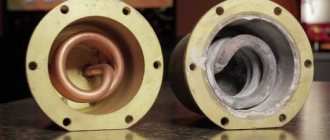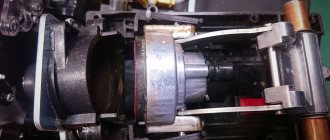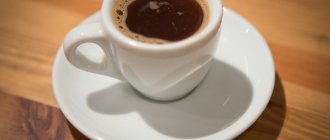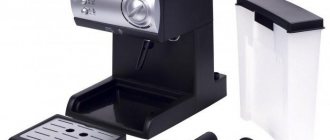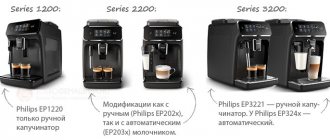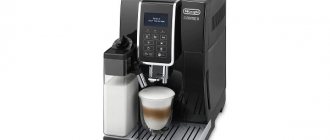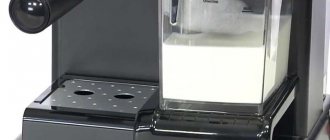A coffee maker, including a drip type, is a household appliance designed for making coffee. The operating principle of such a device is one of the most basic, but when used correctly, it allows you to prepare the required volume of a tasty and invigorating drink.
Despite the availability of more multifunctional devices, this equipment is very often purchased both for home and office, since at the same time it provides automation of coffee preparation along with ease of use. With the right choice, it can replace not only an ordinary Turk, but also a coffee grinder, and will also allow you to prepare tea or another drink, the preparation of which is carried out according to the brewing principle.
What is a drip coffee maker
The operating principle of a drip coffee maker also determined its name. The water is heated almost to a boil and in this form passes drop by drop through ground coffee placed in a special filter. From there, the finished drink flows in the same drops into the coffee pot.
This is where the name of the device, known at the beginning of the 19th century, came from. Of course, the devices for this procedure were more primitive, but the hot water was just as saturated with the taste and aroma of the grains. Gradually, with the advent of household appliances, electric coffee makers operating on the drip principle were developed.
Around the middle of the 20th century, the device took shape in its modern form and since then has only developed and improved. Currently, machines provide quick preparation of several servings of coffee at once, without any effort. Most of the processes are automated, so the coffee is prepared without outside intervention. All you have to do is add water and ground coffee by hand.
How do drip coffee makers work?
Drip coffee makers have the simplest design among electrical coffee appliances. Their heater is combined with a stove where a coffee pot is installed. There is a water container and a compartment with a coffee filter. There may be a control board with additional functions, but in simple models, where there is only one on and off button, it is missing.
Drip coffee maker diagram
Water from the reservoir is sent to the heater, then to the coffee compartment, where it brews it, after which the finished drink fills the coffee pot drop by drop. The heater continues to operate so that the coffee does not cool down.
Note! The operating principle is simple. The filter is filled with ground grains, and the tank is filled with water. The lid is closed. Turn on the device and wait a few minutes. Coffee is ready!
Device structure
Despite the variety of models produced by manufacturers, the main components are the same for all coffee makers. The design consists of the following parts:
- Container for cold water. In most models, it is non-removable and is located in the back of the coffee maker.
- A tank is also a boiler for heating water.
- A heating element.
- Special container for placing the filter. In some models it may be removable.
- Self-contained filter, reusable or disposable.
- Jug for ready-made drinks of various configurations.
Starting is carried out using a switch. To heat the coffee, there is a plate that is turned on separately, if necessary.
How does a drip coffee maker work?
The general operating principle of drip coffee makers has been preserved for more than 200 years. They differ only in their modern design and useful additional functions.
A drip coffee maker works as follows:
- Water is poured into a tank located at the rear, and from there it flows by gravity into the heating boiler.
- Hot water rises through the tube.
- Here it passes in the form of drops through the coffee powder poured into the filter.
- The water absorbs all the best qualities of the ground grains and enters the jug in the same drops.
- When the water runs out and stops dripping, the coffee is considered completely ready.
Remaining powder in the form of coffee grounds remains inside the filter, which is washed or thrown away if it is disposable. The area where the jug is installed can be heated, keeping the drink hot for a set time.
What determines the taste of coffee made in a drip coffee maker?
In order for coffee prepared in a drip coffee maker to delight you with its taste, you must not only take a knowledgeable approach to choosing this device, but also follow all the rules for preparing the drink.
So, when brewing coffee, the optimal water temperature can be called 90-95 degrees. Not all devices can achieve this temperature, but only those whose power is about 1000 W. If the equipment available in the kitchen does not have this characteristic, then it is best to pour already hot water into the water container, thereby helping the device bring it to the required temperature. In addition, in this way you can significantly reduce the preparation time of the drink.
The taste of coffee prepared in a drip coffee maker depends directly on the product itself.
For coffee made in a drip coffee maker to be truly tasty and aromatic, it is best to buy bean coffee and grind it before brewing.
The fresher the coffee and its roasting, the more aromatic the drink will be. You should also grind the grains correctly, since coarse grinding will allow water to pass through too quickly, not providing the required strength, and too fine grinding, on the contrary, will retain water, which will lead to bitterness.
Bean coffee is an ideal option for a delicious drink
The water used to make coffee must be as pure as possible, which can only be achieved after using a filter.
If there are no possibilities for filtering water, then in this case it is better to choose a coffee maker model in which it is built inside the device and independently ensures good quality of the liquid.
Types of filters
The filter is considered an important element of the coffee maker. It determines how fully the beneficial properties of ground coffee will be transferred to hot water.
Reusable
Many coffee makers are initially equipped with reusable filters. The following products are mainly used:
- Metal. Requires cleaning and washing after each use. The drink may contain small particles of grounds and acquire an unpleasant metallic taste.
- Nylon. Can be used 60-80 times. It is also necessary to wash after each use.
- "Golden". In fact, they are nylon with titanium coating, which extends their service life.
How to use a drip coffee maker correctly
A drip coffee maker can quickly prepare Americano with great taste and aroma. A good result can be achieved by first studying the operating instructions.
Those who first encountered this device should be guided by the following rules:
- Connect the device to a voltage source.
- Water is carefully poured into the tank.
- A filter is installed in the container. Next, it is filled with ground coffee in the amount of 1 teaspoon per 0.1 liter of water. In the future, the dosage can be adjusted to your own taste.
- The coffee pot for the finished product is installed on the platform.
- Press the start button and start the device. Further, all processes are performed automatically.
- Wait until the drink is ready and remove the jug from the stand.
- It is advisable to rinse a reusable filter immediately before it dries out, and simply throw away a disposable filter.
Exact adherence to the rules does not always lead to the desired result. Preparation, which is also carried out in a certain order, is of great importance. Much depends on the coffee itself, the water used, various additives and other factors.
Popular models
- Panasonic NC-ZF1HTQ (approximate cost 8,500 rubles) - drip coffee maker with a power of 900 W, coffee pot capacity - 0.96 liters. Advantages of the model: a thermocoffee pot made of metal is used as utensils; it allows you to keep coffee hot for a long time, as well as the presence of an anti-drip system, an indicator of the water level and the inclusion of the device. Disadvantages - significant cost, short power cord and unclear water level scale;
Panasonic NC-ZF1HTQ - Melitta Optima Glass Timer (approximate cost 5,500 rubles) - drip coffee maker with a 1.1 liter glass coffee pot, power - 850 W. The advantages of the device include the ability to set the exact time at which coffee will be prepared, an anti-drip system, automatic shutdown after 30 minutes, with the ability to increase the time to 120 minutes. The device control allows you to select 1 of 4 types of water according to hardness. The period of self-cleaning from scale depends on this. A significant drawback is the lack of a reusable filter;
Melitta Optima Glass Timer - Philips HD 7457 (approximate cost 3,400 rubles) - drip coffee maker with a power of 1000 W, coffee pot capacity - 1.2 liters. The advantages are expressed in the presence of additional functions (auto-heating, anti-drip system, water level and power indicator). Disadvantages - lack of auto-shutdown, due to which the heating element of the device will have an increased temperature until it is turned off, uninformative operating instructions.
Philips HD 7457
Helpful tips before making coffee
The preparatory stage is no less important than the process of making coffee itself. This largely determines how tasty and high-quality the finished drink will be.
Therefore, when preparing for cooking, you need to pay attention to the following:
- Only purified bottled water is used. It is guaranteed not to spoil the taste of coffee and will protect the device from scale.
- After grinding, the coffee powder is placed in an airtight container. All beneficial properties will remain for a long time.
- It is recommended to preheat the jug where the finished coffee is collected.
- It is strictly forbidden to use broken or damaged filters. In this case, the coffee maker is highly likely to fail.
Reviews of the Bosch coffee maker
The Bosch drip coffee maker also boasts many positive reviews. Among the functions noted by users, mention should be made of automatic shutdown when boiling and control of drink strength. A thermos coffee pot will allow you not to heat up the finished drink. It closes tightly so you can drink the contents throughout the day.
As manufacturers of elite types of coffee makers, these companies have more positive reviews than other brands. Each consumer chooses the best option based on their capabilities and needs.
After familiarizing yourself with the features of the device, operation, as well as consumer reviews of such a device as a drip coffee maker, everyone can choose the most suitable option for themselves. Preparing a drink using this type of technique will help capture all the beauty of the aroma of freshly ground beans and transfer it to every cup of coffee.
What determines the taste of brewed coffee?
The properties of the final product depend on many factors. True coffee connoisseurs, who consistently achieve high results, always adhere to generally accepted rules and recommendations. These tips include:
- Beans should not be roasted over a long period of time. The maximum period is 2 months. During this period, oxidation of essential oils occurs, evaporation of active components even in closed packaging. When purchasing coffee beans, you should check the roasting date.
- After opening the package, the grain should not be stored in it for more than 7 days. During this time, some part will oxidize and evaporate, and after the specified period, there will be even more losses. The drink will no longer have such a bright and rich taste as when using fresh grain. For home use, it is better to buy small packs of grains - no more than 250 grams, which is just enough for a week.
- The grain, ground into powder, must be used within half an hour. During this period, essential oils actively evaporate and after 30 minutes many properties will simply be lost. If you compare drinks made from freshly ground beans and after a 30-minute pause, their taste will be significantly different.
- Water mineralization is average, from 75 to 150 mg per 1 liter. With low mineralization, many unpleasant components are drawn out of coffee along with beneficial substances. At high levels, on the contrary, most of the nutrients will remain in the grains. There are special instruments for measuring water mineralization. They are used not only in coffee shops, but also at home.
- Grinding quality. The release of the taste qualities of coffee to water largely depends on this. The smaller the particles, the higher the rate of absorption of nutrients. With the same grain sizes, extraction occurs simultaneously in each of them. The beneficial substances are extracted evenly, and the coffee quality is close to ideal.
- Extraction percentage. The most optimal figure is considered to be in the range of 18.5-21%. Individual components are extracted at different speeds: first, volatile aromatic substances leave, followed by sweetness, and caffeine and bitterness complete the process. In real coffee, they are all optimally balanced and complement each other in taste. The ideal balance is achieved experimentally by varying the grind size and water temperature.
- Timely cleaning of equipment. After use, the walls of the device are covered with particles of powder and essential oils. If they are not removed, they can oxidize and gradually stick to the surface. This will cause the drink to feel rancid, the further it goes, the more so. It is recommended to care for the coffee grinder daily, using improvised or special cleaning products for cleaning.
The most popular coffee recipes
Espresso
To make espresso you will need ground coffee beans (9 g) and water (30 ml). The cooking process is performed in the following sequence:
- Ground coffee is poured into the filter.
- Water is poured into the container.
- The coffee machine turns on and further actions are performed automatically.
- When all the drink has collected in the coffee pot, it is poured into cups that need to be preheated.
Latte
Lightened coffee latte is made from several components. You will need ready-made espresso (50 ml), milk (200 ml), cinnamon (1 pinch), chopped nuts (3 g).
Preparation includes a certain procedure:
- Espresso coffee is prepared in a coffee maker and then poured into a high-sided glass.
- The milk is whipped with a mixer or blender.
- Frothed milk is poured over the espresso.
- Milk foam is placed on top.
- The surface of the foam is sprinkled with cinnamon and nuts.
Viennese cappuccino
The main ingredients for cappuccino will be pre-prepared espresso (50 ml), whipped cream (50 ml), milk (200 g), chocolate (20 g). The drink is created according to the following recipe:
- Heat the milk and pour it into a glass.
- The espresso is poured in slowly and carefully.
- Whipped cream is placed on top.
- Chocolate chips are scattered on the surface of the cream.
Irish coffee drink
This drink is very popular in Ireland. To create it you will need ready-made espresso (60 ml), sugar (20 g), cream (40 ml), whiskey (30 ml), water (20 ml).
Reviews of coffee makers
Based on reviews from consumers who use drip coffee makers, we can conclude that the power of the device plays an important role in the final result. A lower wattage appliance will produce stronger coffee. This is due to the speed at which water passes through the filter.
For home cooking of only 2-4 cups, a power of 750-800 W is suitable. This would be the best option for a device such as a drip coffee maker. Consumer reviews suggest that to prepare a larger amount of drink at a time, you should choose a higher power.
A coffee pot is most often made of glass. However, according to people who brew this hot drink in a machine of the type presented, it is better to use a thermos coffee pot made of metal with thermally insulated walls.
Pros and cons of drip coffee makers
There are many coffee makers, but the easiest to use are drip, carob and capsule models. They all differ in their advantages and disadvantages. Among the advantages are the following:
- The drip device can work with any ground coffee.
- All devices are compact in size and easily fit in the kitchen.
- Simple control, start-up is done by pressing a button. All other actions are performed automatically until the process is completed.
- Drip and capsule models do not have complex mechanisms.
- The filter prevents coffee grounds from entering the cup.
- All coffee machines can be easily and quickly washed from dirt.
- The results are aromatic drinks with a mild taste.
- You can prepare other drinks - tea or cocoa.
As with other devices, there are some downsides:
- A drip coffee maker cannot make strong coffee. Water passes through the powder without pressure, so less flavors and nutrients get into it.
- Carob and capsule models require certain varieties and varieties.
- The design of a carob coffee maker is more complex due to the pump and other components.
- Frequent filter replacement and increased coffee consumption.
Advantages of a coffee maker with auto shut-off:
Water poured into the container is boiled in full. Next, the heating mode is turned on for a certain time. At the end of the set period, the coffee maker automatically turns off. Thus, there is no need to constantly monitor the device so that the water does not boil out of it.
Components of a drip coffee maker
All drip-type coffee makers include a flask made in the form of a jug. There is also a reservoir for water. This container has a graduation scale to determine the amount of liquid poured into it.
The shape of the jug doesn't really matter, although some manufacturers claim that having a specific configuration improves the taste of the coffee.
An integral part of the device is a filter for a drip coffee maker. This element could be:
- paper (disposable);
- nylon;
- "gold".
Most often, a regular nylon filter is included in the kit. It is reusable. A type of nylon filter is “gold”, which differs only in the presence of a special titanium nitride coating. This extends the service life of this element. Paper filters for drip coffee makers, although they require constant costs for their purchase, are the most environmentally friendly type.
Manufacturers often provide a coffee warming stand.
Step-by-step instructions for use
Before using the coffee maker, it must be prepared for use. A new device sometimes smells like plastic and may emit other technical odors. Therefore, the following steps must be taken beforehand:
- Water is poured into the entire volume of the tank. There is no need to install a filter or pour powder inside the container.
- Turn on the device and wait until all the water follows the intended paths inside the coffee maker and collects in the coffee pot.
- The device turns off and remains in this form along with water for 15-20 minutes.
- The procedure should be repeated at least 3 times. During this time, foreign odors will completely disappear and the device can be used for its intended purpose.
Before you start using it, be sure to read the instructions on how to use the coffee maker. In any case, all actions are performed in several stages:
- Filling with water. It is poured at the very beginning, in the quantity necessary to obtain certain qualities of the drink - strength and taste. Monitor the upper level and do not overfill. During filling, water should not get on other parts of the device.
- Filter installation. Placed in a special container. Can be reusable - nylon or metal. Disposable paper filters are often used - more convenient and effective. Thanks to their use, it is possible to completely avoid the unpleasant tastes characteristic of reusable elements.
- Adding ground coffee. Typically, 1 cup requires 2-3 teaspoons. The required amount of powder is poured directly into the filter. The jug for the finished drink should be in its place. The device turns on, the coffee is prepared and collected in a container. The whole process takes on average 4-10 minutes. If there is no automatic shut-off, you must turn off the coffee maker yourself.
Principle of operation
Any drip-type coffee maker provides a certain technology for the process of preparing the drink.
At the initial stage, the device prepared in advance begins to heat the water in it. When the temperature of the liquid reaches 87˚C, the cooking stage begins.
The process of hot water passing through the ground coffee in the filter occurs. At this stage, the hot liquid absorbs all the aroma of the substance and, taking away its taste, flows into the coffee pot.
The water must pass through the filter slowly so that the finished drink has a rich taste.
Rules of care
How to clean a drip coffee maker
The reliability and durability of the coffee maker largely depends on timely and proper care. An important element is to wash the device after each use. Reusable filters are washed with water, and better cleaning is carried out at least once a month. This procedure is performed using citric acid according to the following scheme:
- Citric acid (30 g) is mixed with water (500 ml). After the crystals have completely dissolved, another half liter is added.
- Half of the finished liquid is poured into the reservoir, after which the device must be turned on and started in the operating cycle.
- Wait until the water has completely drained into the coffee pot and turn off the device.
- The machine remains in this form for 20 minutes, after which the remainder of the solution is poured into the container again, and the coffee maker is put into operation.
- After the solution has completely flowed into the coffee pot, you need to run clean water through the device 2-3 times to remove the remaining solution.
What to wash with: Household and special products
The maximum positive result can be achieved using a special household chemical intended for cleaning coffee makers. For this purpose, descaling tablets Topper 3043/3044 are used. They apply as follows:
- The tablet is released from the protective film and placed in the reservoir.
- Hot water is poured into the container. After the tablet has completely dissolved, a full operating cycle is activated to remove scale.
- After cleaning, the device must also be run with clean water 2-3 times to remove the remaining cleaning agent from the internal parts.
Recommendations when choosing coffee for a coffee maker
In order to get tasty and aromatic coffee, you need to choose the right starting product. All information about coffee powder or beans is indicated on the packaging.
The most popular coffee brands are the following:
- Lavazza Filtro Italiano Delicato. We use high quality beans, roasted by the best Italian specialists. Original taste with hints of honey and chocolate.
- Paulig Presidentti Original. Finnish brand using Arabica beans from Brazil and other Central American countries. Balanced taste with a slight berry tint.
- Illy Filter Coffee. The composition includes 9 varieties of Arabica with a rich aroma and taste.
